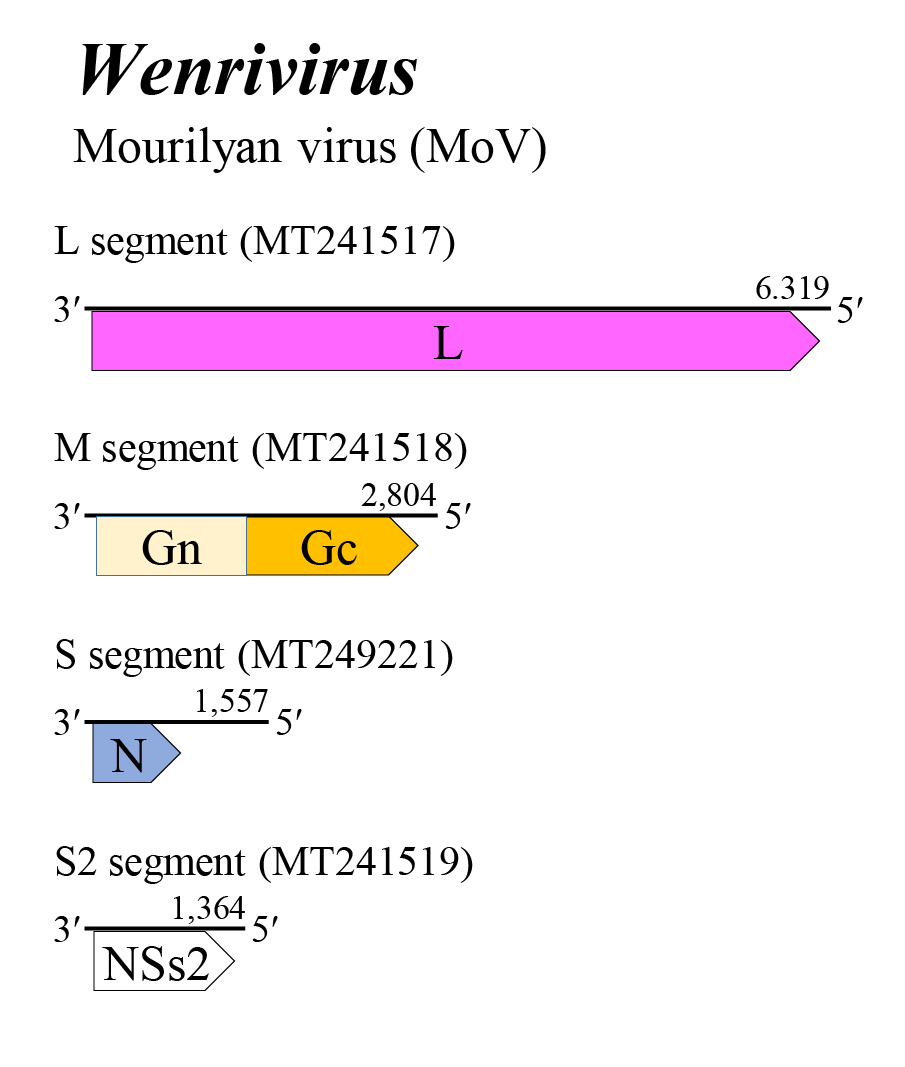Family: Phenuiviridae
Genus: Wenrivirus
Distinguishing features
Mourilyan virus (MoV) is assigned to Wenrivirus penaei, the only species in the genus. Wenrivirus RNA has been found in RNA from prawns and shrimps from Mourilyan in Australia and Wēnzhōu (温州市) in China. The wenrivirus genome has four genes, encoding a large protein (L), two external glycoproteins (Gn and Gc), a nucleocapsid protein (N) and a non-structural protein (NSs). Based on well-supported Maximum Likelihood or Maximum Clade Credibility trees inferred from complete L protein sequences, viruses classified in the genus Wenrivirus form a monophyletic cluster clearly distinguished from other phenuivirids (Li et al., 2015, Cowley 2021).
Virion
Morphology
Virions are spherical or pleomorphic, 85–100 nm in diameter, and have surface glycoprotein projections which are embedded in a lipid bilayer envelope (Cowley 2016).
Nucleic acid
The wenrivirus genome encompasses four segments of negative-sense RNA: L (6.3 kb), M (3.0 kb), S (1.6 kb) and S2 (1.4 kb). The terminal nucleotides of each segment occur in a canonical, conserved sequence (in coding sense) 5′-ACACAAAGAC…CUCUUUGUGU-3′ and may form panhandle structures typical of other members of the class Bunyaviricetes (Table 2 Phenuiviridae). All four genomic RNAs contain untranslated regions flanking a single ORF which, based on comparisons with other negative-sense RNA viruses, is predicted to be contained in the virus complementary strand. In silico analysis of wenrivirus putative ORF sequences suggests that the wenrivirus genome encodes four structural proteins: an RNA-directed RNA polymerase (RdRP) with a predicted molecular mass of 233 kDa, a glycoprotein precursor of 99 kDa (comprising Gn and Gc) and N of 27 kDa, these proteins sharing sequence homology and/or structural characteristics with the cognate proteins of other phenuivirids (Table 3 Phenuiviridae) (Li et al., 2015, Cowley 2021).
Genome organization and replication
The wenrivirus genome consists of four negative-sense RNA segments (Figure 1 Wenrivirus). The L, M, and S1 segments putatively encode L, a glycoprotein precursor (comprising Gn and Gc) and N, respectively. The Gn and Gc glycoproteins of 48 kDa and 52 kDa were earlier referred to as G1 and G2 based on apparent size following gel electrophoresis. The S2 segment encodes NSs, a 46 kDa protein of unknown function. This genome arrangement is similar to that of members of the genus Horwuvirus. Details of virus replication are unknown (Li et al., 2015, Cowley 2021).
 |
| Figure 1 Wenrivirus. Genome organization of a wenrivirus. Coloured boxes depict ORFs that encode N, nucleocapsid protein; Gn and Gc, external glycoproteins; and L, large protein. A white box depicts an ORF that encodes NSs2, non-structural protein. |
Biology
Mourilyan virus (MoV) occurs commonly in black tiger prawns [Penaeus monodon (Fabricius, 1798)] and kuruma shrimps [P. japonicus (Bate, 1888)] farmed in Australia and China. The viral infection increases the mortality of the prawns and shrimps (Cowley 2020).
Species demarcation criteria
Not defined as the genus currently includes only a single species.
Related, unclassified viruses
| Virus name | Accession number | Virus abbreviation |
| oriental wenrivirus 1 (=Bunyavirales sp.) | L: MK335503; M: MK335504; S: MK335505; S2: MT040832 | OWV1 |
Virus names and virus abbreviations are not official ICTV designations.

